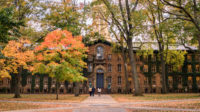Radical Pedagogies Explores Teaching Lessons from the Past
Review: 'Radical Pedagogies,' By Beatriz Colomina, Ignacio G. Galán, Evangelos Kotsioris, and Anna-Maria Meister

The publication of Radical Pedagogies, documenting a series of experiments with institutional transformation in the 1960s and ’70s, coincides with a current moment of reexamination and reflection. What began as a research seminar led by Beatriz Colomina at Princeton’s School of Architecture, has evolved into exhibitions, conferences, workshops, and now this weighty tome, which collects 113 accounts of innovative teaching techniques and organizational models implemented in architecture and design programs around the globe. These accounts are presented as a dossier, recording dates, protagonists, and the events that took place. Some entries, like the road-trip format of Robert Venturi, Denise Scott Brown, and Steve Izenour’s Learning from Las Vegas studio, are a part of the lore of architectural education. Other entries, from Nairobi, New Zealand, MIT, and the Szczecin University of Technology in Poland, are far less familiar, and expand our understanding of the global networks of architecture and design schools.
The creation of the Escuelas Nacionales de Arte in Cuba in 1965 marked a moment of revolutionary fervor with the construction of a brick-vaulted school that actively worked to dismantle the separation of students and builders. At the Catholic University in Valparaiso, Chile, students and faculty investigated surrealist techniques of automatic writing and poetic acts. They erected new structures to form what they called Ciudad Abierta, or Open City. Other pedagogical experiments dispensed with the geographic specificity of the physical school completely. The Polyark Bus, a converted double-decker vehicle for living and learning, launched a nomadic program in UK cities. The Black Workshop at Yale was founded in 1968 to support Black students and serve the broader New Haven community. It conducted fieldwork studios and developed methods of community design with the participation of notable Black architects like Max Bond Jr. and Donald Stull, raising social-justice issues as design concerns.
At the core of the Radical Pedagogies research project lie questions about the role of institutions and how they evolve to be in or out of sync with their respective context and time. The episodes covered shed light on the legacies of institutions and practices that are still being felt today. The authors draw a direct comparison—and make a critique—of the current state of design schools, writing in the introduction, “Radical Pedagogies brings to light a panorama of past attempts to subvert the status quo, and reveals work to build upon and ideas waiting to be taken up again. It is a stocktaking of potentials, an invitation to open new paths and formulate an unruly set of new questions for both architects and architecture historians to address . . .”
The events described in the book coincide with a period of cultural transformation marked by the Cold War, the civil rights movement, and global decolonization. The combined crises we face today raise questions about: how the built environment is implicated in, and in some cases serves as a tool for, constructing inequity; how it consumes and embodies energy; and how it reinforces dominant power structures. If design produces inequities, could it alternatively be applied for the inverse? If architectural pedagogies contributed to inequities of the past, how would curricula need to change to be realigned to go toward that alternate future?
The contribution of Radical Pedagogies is how it documents such varied accounts from diverse institutions. In some cases, the activism tapered off after several years; in others, the new pedagogical models became absorbed into the institutions and reshaped them. For me, writing as a practitioner and educator, the episodes in the book seem highly resonant with this moment, where students are leading efforts to review the legacies of the past and insisting on the reevaluation of inherited assumptions about courses and curricula, the culture of architecture, and the canon.





